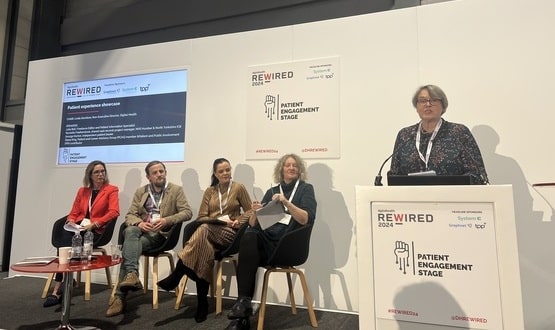Putting the patient at the centre when digitalising systems and processes is a must, speaker told a session on the Patient Engagement stage at Rewired24 Wednesday. The key is to communicate with patients through every step of the process for effective systems in healthcare and beyond, writes Kardelen Yuce.
Rochelle Featherstone, diagnosed with Type 1 diabetes, shared her perspective during the afternoon session on patient experience, echoing the sentiment of her sister Elise Featherstone, stating, “A hybrid closed loop system isn’t just life-changing for a diabetic, it’s lifesaving.” She emphasised the transformative impact of this technology on her life, allowing her to regain control and confidence in managing her condition.
Prior to adopting the hybrid closed loop system (HCL), Rochelle experienced anxiety and struggled to maintain blood glucose levels within a healthy range. With the HCL, her time within the target range has significantly improved, often exceeding 70% and reaching as high as 80-90% daily.
Reflecting on the broader impact of diabetes technology, individuals Rochelle spoke to highlighted its liberating effect, freeing them from the constant burden of Type 1 diabetes on themselves and their families. However, Rochelle also acknowledges challenges in accessing such technology, with 30.5% resorting to self-funding due to disparities in availability across different regions.
Despite these challenges, Rochelle remains optimistic about the future, recognising the transformative potential of digital solutions in improving lives.
George Norton, a patient himself, provided insight into the patient perspective, stressing the importance of involving patients from the outset in the development of healthcare technology. He emphasised the need for simplicity in technology solutions, noting that while flashy innovations garner attention, it is often the simplest solutions that patients truly require.
“When you look at these things from the patient perspective, there’s a lot of flashy tech, there’s lots of really good stuff that sounds brilliant, looks great, but often it’s the simplest stuff that patients really need. But how do you know about that unless you’ve got the patients involved right from the beginning.”
“For me, technology has that opportunity to take away some of that admin burden, and I know a lot of you may be working with companies that make those admin parts easier for the clinicians, but what about making the experience easier for the patients as well,” said Norton.
Diana King emphasised the importance of patient portals enhancing, rather than replacing, traditional forms of communication and personal contact in healthcare. She spoke on the potential for patient involvement to enhance the development process and final outcomes of healthcare technology.
Patient-centred approaches in the development and implementation of healthcare technology is vital, recognising the potential for digital solutions to significantly improve patient outcomes and experiences.
Julia Bell, a freelance editor and specialist in patient information, honoured her late sister, Daloni Carlisle, a greatly missed journalist who made significant contributions to digital health over many years until her premature passing from womb cancer.

